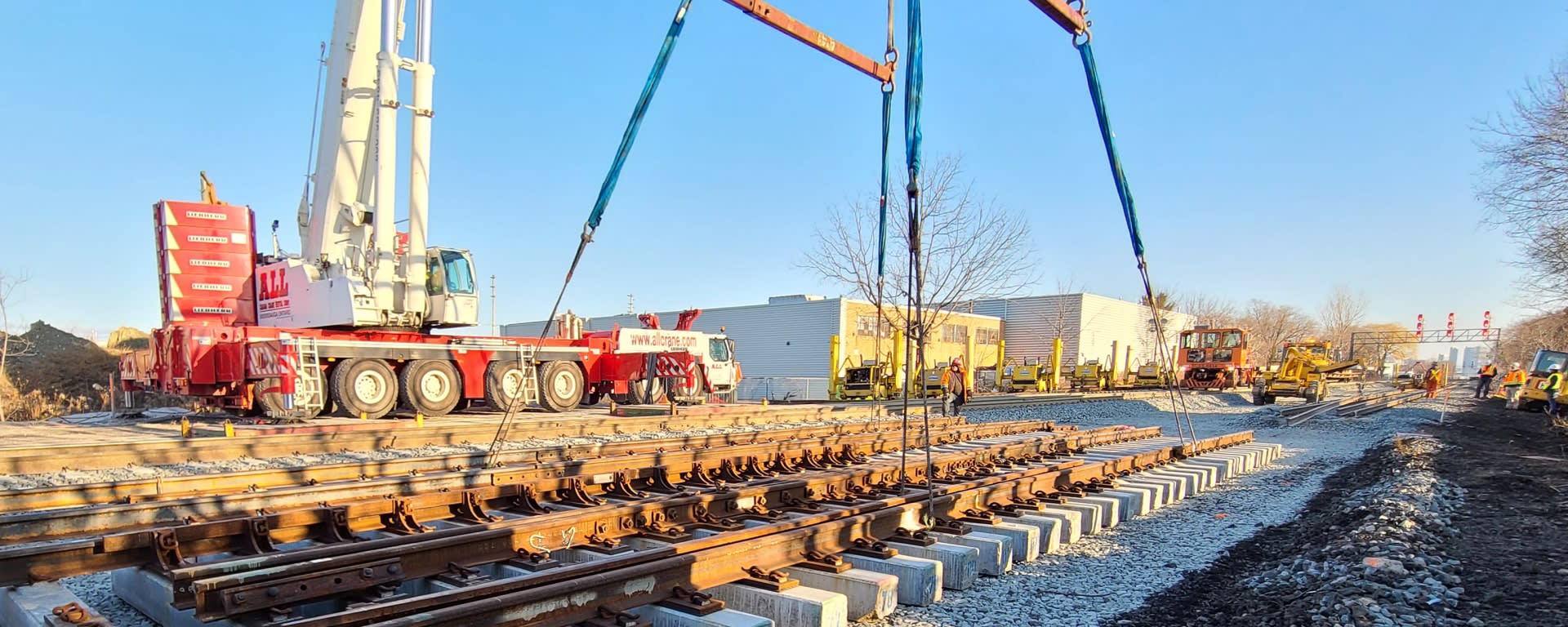Major track upgrades on Canada’s busiest rail corridor continue
Significant progress has been made on overhauling a well-worn section of the Lakeshore West Line.
Dec 30, 2020
Imagine rebuilding Highway 401 all while the traffic continues to zoom by.
That’s what the Metrolinx corridor maintenance team is doing right now – except instead of a highway, it’s the train equivalent – the Lakeshore West GO corridor.
Both are the busiest routes of their kind in Canada and doing major upgrades on either can be challenging.
But with the proper protocols in place Metrolinx teams have been safely meeting those challenges since earlier this year as they work to upgrade a key segment of the Lakeshore West GO line near Long Branch GO – one that will bring better train service for thousands of GO customers for decades to come.
A switch plant is a major piece of rail infrastructure made up of track and signalling components that allow trains to safely switch from one track to another – these photos were taken while the tracks were shutdown to ensure the safety of the workers. (Metrolinx photo)
What is the Canpa switch?
The entire project is centred around overhauling the Canpa switch plant.
Not everyone speaks rail. So what exactly is a ‘switch plant’?
It’s a major piece of rail infrastructure composed of track and signalling components that allow trains to safely switch from one track to another, all while maintaining speed. Switch plants in general, contain multiple turnouts that act together or individually across any number of tracks.
Depending on who you’re talking to in the rail industry, switches are also known as ‘turnouts’.
This section of track is just east of Long Branch GO Station and is a vital part of the GO Network as it’s near the Willowbrook Maintenance Facility and other key rail locations – these photos were taken while the tracks were shutdown to ensure the safety of the workers. (Metrolinx photos)
The Canpa switch is particularly vital as it keeps GO trains running smoothly on the busiest line in the network. It also helps route trains into the Willowbrook Rail Maintenance Facility, the VIA Maintenance Facility, the Canpa Spur, and more.
Replacing this infrastructure will also shave off precious minutes for train times. While that may not sound like much, every minute gained makes a huge difference in cutting down on rail congestion and makes way for future service increases.
Metrolinx officials say this work is being done now to ensure the transit agency has the ability to add more GO service in the future, increase speeds and improve current service reliability.
On top of the customer benefits, the project is also making Canadian rail history. Instead of using traditional wooden rail ties through these turnouts, construction crews are using concrete rail ties when installing the new switch plant
Metrolinx’s corridor maintenance team says this type of construction gives the rail infrastructure a longer lifespan and could last 40 to 50 years, instead of the usual 25 years.
How much work has been done so far?
Since work began on the project earlier this fall, here are some interesting facts on the work completed thus far:
- Four weekends of work (including 3 minor closures and 1 major closure)
- More than 25 workers on site each weekend
- 1,109 metres of new track with concrete ties have been installed
- The first ever concrete crossover installed in Canada
- The old Canpa signal tower was demolished to make room for new rail infrastructure
The installation of concrete crossovers is heavy duty work. The panels assembled for this kind of installation are approximately 18 metres long by six metres wide, weighing up to 50 tonnes. You can tell your children it makes it about 14 times as heavy as a typical tyrannosaurus rex.
These large sections of track with concrete rail ties can weigh up to 50 tonnes, that requires heavy duty machinery. (Metrolinx photo)
Major Construction on the Horizon
Replacing several kilometres of track and replacing major rail infrastructure is more than a one weekend job, especially on one of the busiest sections of track in the country.
Metrolinx says there is still more than 1,800 metres of track to install as well as multiple crossovers and turnouts.
While much of the work will be done while train service still operates, Metrolinx says multiple weekend shutdowns on the Lakeshore West line will be needed over the next year to complete the work. This will allow crews to operate heavy machinery and not have to stop as trains pass.
The transit agency says customers will be given advanced notice before any weekend closures and alternative travel options will be put in place to make sure people can still get where they need to go.
The entire project is expected to be operational in late 2021, with total completion in 2022.
by Scott Money Metrolinx editorial content manager
